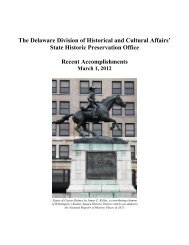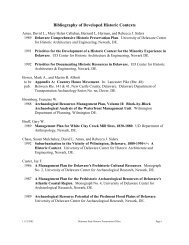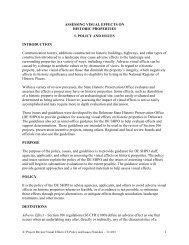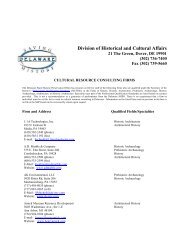Report of the Archaeological Investigations of the New Castle Court ...
Report of the Archaeological Investigations of the New Castle Court ...
Report of the Archaeological Investigations of the New Castle Court ...
Create successful ePaper yourself
Turn your PDF publications into a flip-book with our unique Google optimized e-Paper software.
NEW CASTLE COURT HOUSE PLAZA<br />
NEW CASTLE, DELAWARE<br />
3.0 FIELD RESULTS<br />
artifacts within this deposit exhibited extremely worn edges; a wear pattern most likely caused by<br />
water erosion. This suggests that a percentage <strong>of</strong> <strong>the</strong> artifacts were probably imported onto <strong>the</strong><br />
site within <strong>the</strong> fill matrix.<br />
3.1.5 LOWER SILT LOAM DEPOSIT – FEATURE 19 (SU E)<br />
The lowest fill deposit corresponds to an artifact dense layer directly overlying <strong>the</strong> subsoil and an<br />
alluvial wash on <strong>the</strong> east plaza. From this layer, a total <strong>of</strong> 2111 artifacts were collected and a TPQ<br />
<strong>of</strong> 1810 was assigned based on two sherds <strong>of</strong> Albany slip stoneware recovered from EU 28.<br />
Recovered faunal material include bone, clam and oyster shell fragments; personal items<br />
consisted <strong>of</strong> slate pencil and writing slate fragments, marbles, a glass figurine, bone and brass<br />
buttons, an unidentified domestic coin, fan fragments, brass straight pins, a brass safety pin, brass<br />
tacks, glass beads, ball clay tobacco pipe fragments, and gun flint fragments; <strong>the</strong> ceramic<br />
assemblage, dating from <strong>the</strong> seventeenth to nineteenth centuries, was composed <strong>of</strong> tin glazed<br />
ear<strong>the</strong>nware, buff-bodied ear<strong>the</strong>nware, redware, creamware, pearlware, porcelain, white saltglazed<br />
stoneware, imported and domestic gray stoneware, imported brown stoneware; glass items<br />
included tableware and free-blown and unidentified bottle glass fragments; unidentified metal<br />
objects; architectural items were comprised <strong>of</strong> cut/wrought nails, mortar, brick fragments<br />
including one yellow brick fragment, and window glass. Prehistoric artifacts, totaling 28,<br />
consisted <strong>of</strong> four unidentified prehistoric body sherds, one chert core fragment, and 23 prehistoric<br />
flakes <strong>of</strong> various material types. An occupation date range <strong>of</strong> 1753.7 to 1803.5 was calculated for<br />
this deposit.<br />
3.1.6 ALLUVIUM (SU F)<br />
An alluvial wash was identified within EUs 9, 24, 27, and 28, <strong>the</strong> area constituting <strong>the</strong><br />
sou<strong>the</strong>astern-most section <strong>of</strong> <strong>the</strong> blocked area on <strong>the</strong> east plaza. An occupation date range <strong>of</strong><br />
1758.6 to 1812.6 was calculated from <strong>the</strong> 52 recovered artifacts. Items recovered include one<br />
quartz flake, 14 bone fragments, nine oyster shell fragments, a ball clay pipe bowl and stem<br />
fragment, one tin glazed ear<strong>the</strong>nware sherd, six redware sherds, five light yellow creamware<br />
sherds, one plain pearlware sherd, a nail, brick fragments, and nine window glass fragments.<br />
Based on <strong>the</strong> recovery <strong>of</strong> <strong>the</strong> plain pearlware sherd from EU 27, a TPQ <strong>of</strong> 1779 was assigned.<br />
3.1.7 SUBSOIL – B HORIZON (SU G)<br />
The final layer observed during <strong>the</strong> excavation was <strong>the</strong> subsoil within <strong>the</strong> eastern section <strong>of</strong> <strong>the</strong><br />
circa 1820 plaza. This natural horizon was not sampled in any <strong>of</strong> <strong>the</strong> units.<br />
3.2 CIRCA 1820 WEST PLAZA STRATIGRAPHIC UNITS<br />
Two foundation deposits, similar to two uppermost fill layers on <strong>the</strong> east plaza, were documented<br />
within <strong>the</strong> western circa 1820 plaza section beneath <strong>the</strong> brick paving surface (Table 2; Figures 9<br />
and 10). Excavation <strong>of</strong> west plaza began with <strong>the</strong> removal <strong>of</strong> a layer <strong>of</strong> organic debris that had<br />
accumulated between <strong>the</strong> brick spacers. This layer consisted <strong>of</strong> black (10YR 2/1), very dark gray<br />
(10YR 3/1) and very dark grayish brown (10YR 3/2) sandy loam to silt loam. Identical to <strong>the</strong> east<br />
plaza, a layer <strong>of</strong> beach sand comprised <strong>the</strong> primary fill within this section <strong>of</strong> plaza and measured<br />
from 0.02 to 0.41 ft. in thickness. Munsell hue and chroma consisted <strong>of</strong> brown (10YR 5/3), dark<br />
yellowish brown (10YR 4/4), and yellowish brown (10YR 5/4) sand with less than 30 percent pea<br />
gravel. At <strong>the</strong> base <strong>of</strong> <strong>the</strong> sand deposit was a fill layer that ranged from 0.01 to 0.58 ft. in depth<br />
23









